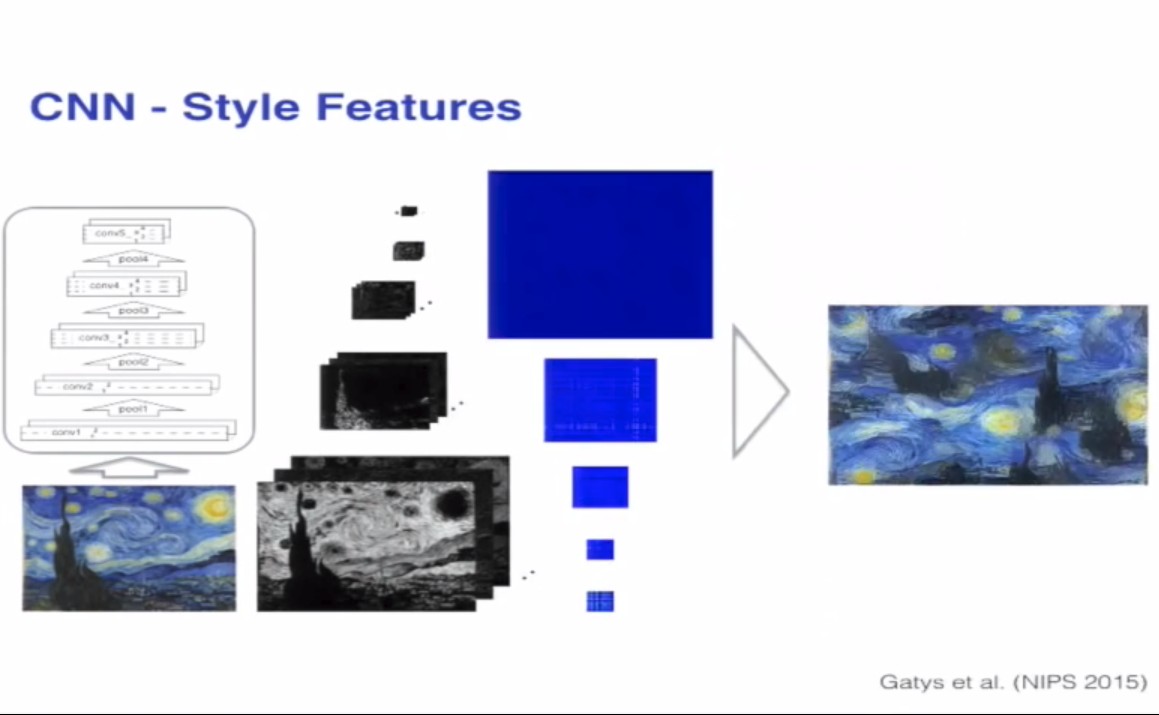说是实现,其实并不是我自己实现的
亮出代码:https://github.com/yunjey/pytorch-tutorial/tree/master/tutorials/03-advanced/neural_style_transfer

# -*- coding: utf-8 -*- from __future__ import division from torch.backends import cudnn from torch.autograd import Variable from torchvision import models from torchvision import transforms from PIL import Image import argparse import torch import torchvision import torch.nn as nn import numpy as np use_cuda = torch.cuda.is_available() dtype = torch.cuda.FloatTensor if use_cuda else torch.FloatTensor # Load image file and convert it into variable # unsqueeze for make the 4D tensor to perform conv arithmetic def load_image(image_path, transform=None, max_size=None, shape=None): image = Image.open(image_path) if max_size is not None: scale = max_size / max(image.size) size = np.array(image.size) * scale image = image.resize(size.astype(int), Image.ANTIALIAS) if shape is not None: image = image.resize(shape, Image.LANCZOS) if transform is not None: image = transform(image).unsqueeze(0) return image.type(dtype) # Pretrained VGGNet class VGGNet(nn.Module): def __init__(self): """Select conv1_1 ~ conv5_1 activation maps.""" super(VGGNet, self).__init__() self.select = ['0', '5', '10', '19', '28'] self.vgg = models.vgg19(pretrained=True).features def forward(self, x): """Extract 5 conv activation maps from an input image. Args: x: 4D tensor of shape (1, 3, height, width). Returns: features: a list containing 5 conv activation maps. """ features = [] for name, layer in self.vgg._modules.items(): x = layer(x) # 依次输出并且截取 if name in self.select: features.append(x) return features def main(config): # Image preprocessing # For normalization, see https://github.com/pytorch/vision#models transform = transforms.Compose([ transforms.ToTensor(), transforms.Normalize((0.485, 0.456, 0.406), (0.229, 0.224, 0.225))]) # Load content and style images # make content.size() == style.size() content = load_image(config.content, transform, max_size=config.max_size) style = load_image(config.style, transform, shape=[content.size(2), content.size(3)]) # Initialization and optimizer target = Variable(content.clone(), requires_grad=True) optimizer = torch.optim.Adam([target], lr=config.lr, betas=[0.5, 0.999]) # 优化目标:target,非网络参数 # 优化的目标并不是网络参数,而是target,target与content要相似,并且target的grammer矩阵要和style的feature要相似 vgg = VGGNet() if use_cuda: vgg.cuda() for step in range(config.total_step): # Extract multiple(5) conv feature vectors target_features = vgg(target) # 每一次输入到网络中的是同样一张图片,反传优化的目标是输入的target content_features = vgg(Variable(content)) style_features = vgg(Variable(style)) style_loss = 0 content_loss = 0 for f1, f2, f3 in zip(target_features, content_features, style_features): # Compute content loss (target and content image) content_loss += torch.mean((f1 - f2)**2) # 用内容来直接衡量loss # Reshape conv features _, c, h, w = f1.size() # channel height width f1 = f1.view(c, h * w) # reshape a vector, c是feature中的通道数目 f3 = f3.view(c, h * w) # reshape a vector # Compute gram matrix f1 = torch.mm(f1, f1.t()) f3 = torch.mm(f3, f3.t()) # Compute style loss (target and style image) style_loss += torch.mean((f1 - f3)**2) / (c * h * w) # 用两个gram矩阵之间的距离来衡量loss # style_loss += torch.mean((f1 - f3) ** 2) # 用两个gram矩阵之间的距离来衡量loss # / c * h * w 保证二者之间的尺度相同 # Compute total loss, backprop and optimize loss = content_loss + config.style_weight * style_loss optimizer.zero_grad() loss.backward() optimizer.step() if (step+1) % config.log_step == 0: print ('Step [%d/%d], Content Loss: %.4f, Style Loss: %.4f' %(step+1, config.total_step, content_loss.data[0], style_loss.data[0])) if (step+1) % config.sample_step == 0: # Save the generated image denorm = transforms.Normalize((-2.12, -2.04, -1.80), (4.37, 4.46, 4.44)) img = target.clone().cpu().squeeze() img = denorm(img.data).clamp_(0, 1) torchvision.utils.save_image(img, 'output2-%d.png' %(step+1)) ''' if step == 0: for name, weight in vgg.state_dict().items(): print(name, weight) if step == 21: for name, weight in vgg.state_dict().items(): print(name, weight) ''' if __name__ == "__main__": parser = argparse.ArgumentParser() parser.add_argument('--content', type=str, default='./png/content.png') parser.add_argument('--style', type=str, default='./png/style.png') parser.add_argument('--max_size', type=int, default=400) parser.add_argument('--total_step', type=int, default=5000) parser.add_argument('--log_step', type=int, default=10) parser.add_argument('--sample_step', type=int, default=1000) parser.add_argument('--style_weight', type=float, default=100) parser.add_argument('--lr', type=float, default=0.003) config = parser.parse_args() print(config) main(config)
代码已经写的很清晰干净,大致思路是作者用gram矩阵来衡量一幅作品的style,用未经过变化的feature map来衡量content的相似度
我觉得比较牛逼的地方有3
1.作者用的是一个训练好的网络,优化的目标根本就不是网络的参数,这与传统的自己搭建网络不同,而是一个target,这个target是网络的输入,这个输入是一个variable,包含梯度信息。这个target是白噪声可以,也可以是content的copy
2.pytorch实现加载一个特定的网络的参数,并且输出特定层的结果,并且根据这些中间层的输出结果,进行梯度回传,非常方便实现
3.这种idea类似于gan,定义两个loss,让网络的输出在这两个loss之间做一个权衡,gan是真假二元对立,style transfer是style与content的互补关系
现在有几个疑问
1.为什么要用grammer矩阵?
作者oral原话是这样说的
What that means is that in each layer we take paires of feature maps we just multiply them pointwise and sum over the spatial extent and that gives us one correlation value . that give us a number that tells me how correlated are these two features in response to that particular image and if we do all the feature maps in the layer we get a whole correlation matrix and we can do that for multiple layers of the network and then have a texture model with which we model the style, and we can now visualize what information is captured by these curl feature map correlations by generating a new image that now doesn't reproduce the extra feature responses in the network but rather reproduce the correlations between feature responses
然后作者就放出了这一张图

知乎上一位大神回答的比较好,我想补充一下,https://www.youtube.com/watch?v=UFffxcCQMPQ,这个是作者的oral视频,作者的思路可能更多的是实验性的结果,因为作者做了这样一个实验
用不同层的输出的gram矩阵作为衡量,输入白噪声,计算loss,这样训练几轮,优化的之后的白噪声能够丢失outline以及细节信息,反而恢复的是一些style,feature
2.用grammer矩阵为何要除以/(c*w*h),我想了好久,找不出原因,难道是尺度的问题?
我做了一个小实验,content与style图片如下



我尝试了一下先除以/c*w*h,style的loss比较低

Step [4800/5000], Content Loss: 80.6877, Style Loss: 487.1260 Step [4810/5000], Content Loss: 80.7026, Style Loss: 486.3426 Step [4820/5000], Content Loss: 80.7246, Style Loss: 485.5407 Step [4830/5000], Content Loss: 80.7389, Style Loss: 484.7999 Step [4840/5000], Content Loss: 80.7581, Style Loss: 484.0170 Step [4850/5000], Content Loss: 80.7689, Style Loss: 483.3676 Step [4860/5000], Content Loss: 80.7863, Style Loss: 482.5543 Step [4870/5000], Content Loss: 80.8044, Style Loss: 481.7750 Step [4880/5000], Content Loss: 80.8238, Style Loss: 481.0148 Step [4890/5000], Content Loss: 80.8351, Style Loss: 480.3542 Step [4900/5000], Content Loss: 80.8555, Style Loss: 479.5468 Step [4910/5000], Content Loss: 80.8675, Style Loss: 478.8164 Step [4920/5000], Content Loss: 80.8801, Style Loss: 478.0892 Step [4930/5000], Content Loss: 80.8959, Style Loss: 477.3603 Step [4940/5000], Content Loss: 80.9091, Style Loss: 476.5545 Step [4950/5000], Content Loss: 80.9220, Style Loss: 475.8526 Step [4960/5000], Content Loss: 80.9387, Style Loss: 475.0789 Step [4970/5000], Content Loss: 80.9549, Style Loss: 474.3080 Step [4980/5000], Content Loss: 80.9718, Style Loss: 473.5461 Step [4990/5000], Content Loss: 80.9910, Style Loss: 472.7648 Step [5000/5000], Content Loss: 81.0086, Style Loss: 471.9411
输出的图片是这样的





然后我尝试了一下没有进行除以/c*w*h网络的loss输出如下,

Step [4800/5000], Content Loss: 90.9087, Style Loss: 259023120.0000 Step [4810/5000], Content Loss: 90.9227, Style Loss: 258663088.0000 Step [4820/5000], Content Loss: 90.9379, Style Loss: 258286064.0000 Step [4830/5000], Content Loss: 90.9492, Style Loss: 257919232.0000 Step [4840/5000], Content Loss: 90.9621, Style Loss: 257566096.0000 Step [4850/5000], Content Loss: 90.9756, Style Loss: 257201568.0000 Step [4860/5000], Content Loss: 90.9899, Style Loss: 256855216.0000 Step [4870/5000], Content Loss: 91.0036, Style Loss: 256477552.0000 Step [4880/5000], Content Loss: 91.0191, Style Loss: 256127024.0000 Step [4890/5000], Content Loss: 91.0332, Style Loss: 255794784.0000 Step [4900/5000], Content Loss: 91.0459, Style Loss: 255433952.0000 Step [4910/5000], Content Loss: 91.0617, Style Loss: 255089968.0000 Step [4920/5000], Content Loss: 91.0733, Style Loss: 254741968.0000 Step [4930/5000], Content Loss: 91.0890, Style Loss: 254383136.0000 Step [4940/5000], Content Loss: 91.1015, Style Loss: 254048224.0000 Step [4950/5000], Content Loss: 91.1160, Style Loss: 253700608.0000 Step [4960/5000], Content Loss: 91.1338, Style Loss: 253371728.0000 Step [4970/5000], Content Loss: 91.1449, Style Loss: 253062304.0000 Step [4980/5000], Content Loss: 91.1602, Style Loss: 252754048.0000 Step [4990/5000], Content Loss: 91.1777, Style Loss: 252447952.0000 Step [5000/5000], Content Loss: 91.1934, Style Loss: 252113584.0000
输出的图片是这样的





其实可以看出,style的loss很高,所以学习得到的style很多,上面的style loss大的图片显然学习到了更多的style
给自己挖个坑,刚刚尝试了一下用特征值之间的偶是距离来进行优化,好像没有收敛,不知道梯度没有传过去还是怎么回事
先放出来代码

# -*- coding: utf-8 -*- from __future__ import division from torch.backends import cudnn from torch.autograd import Variable from torchvision import models from torchvision import transforms from PIL import Image import argparse import torch import torchvision import torch.nn as nn import numpy as np use_cuda = torch.cuda.is_available() dtype = torch.cuda.FloatTensor if use_cuda else torch.FloatTensor # Load image file and convert it into variable # unsqueeze for make the 4D tensor to perform conv arithmetic def load_image(image_path, transform=None, max_size=None, shape=None): image = Image.open(image_path) if max_size is not None: scale = max_size / max(image.size) size = np.array(image.size) * scale image = image.resize(size.astype(int), Image.ANTIALIAS) if shape is not None: image = image.resize(shape, Image.LANCZOS) if transform is not None: image = transform(image).unsqueeze(0) return image.type(dtype) # Pretrained VGGNet class VGGNet(nn.Module): def __init__(self): """Select conv1_1 ~ conv5_1 activation maps.""" super(VGGNet, self).__init__() self.select = ['0', '5', '10', '19', '28'] self.vgg = models.vgg19(pretrained=True).features def forward(self, x): """Extract 5 conv activation maps from an input image. Args: x: 4D tensor of shape (1, 3, height, width). Returns: features: a list containing 5 conv activation maps. """ features = [] for name, layer in self.vgg._modules.items(): x = layer(x) # 依次输出并且截取 if name in self.select: features.append(x) return features def main(config): # Image preprocessing # For normalization, see https://github.com/pytorch/vision#models transform = transforms.Compose([ transforms.ToTensor(), transforms.Normalize((0.485, 0.456, 0.406), (0.229, 0.224, 0.225))]) # Load content and style images # make content.size() == style.size() content = load_image(config.content, transform, max_size=config.max_size) style = load_image(config.style, transform, shape=[content.size(2), content.size(3)]) # Initialization and optimizer target = Variable(content.clone(), requires_grad=True) optimizer = torch.optim.Adam([target], lr=config.lr, betas=[0.5, 0.999]) # 优化目标:target,非网络参数 # 优化的目标并不是网络参数,而是target,target与content要相似,并且target的grammer矩阵要和style的feature要相似 vgg = VGGNet() if use_cuda: vgg.cuda() for step in range(config.total_step): # Extract multiple(5) conv feature vectors target_features = vgg(target) # 每一次输入到网络中的是同样一张图片,反传优化的目标是输入的target content_features = vgg(Variable(content)) style_features = vgg(Variable(style)) style_loss = 0 content_loss = 0 for f1, f2, f3 in zip(target_features, content_features, style_features): # Compute content loss (target and content image) content_loss += torch.mean((f1 - f2)**2) # 用内容来直接衡量loss # Reshape conv features _, c, h, w = f1.size() # channel height width f1 = f1.view(c, h * w) # reshape a vector, c是feature中的通道数目 f3 = f3.view(c, h * w) # reshape a vector # Compute gram matrix f1 = torch.mm(f1, f1.t()) f3 = torch.mm(f3, f3.t()) _, lam1, _, = torch.svd(f1) _, lam2, _, = torch.svd(f3) cond1 = lam1[1]/lam1[-1] cond2 = lam2[2]/lam2[-1] # Compute style loss (target and style image) # style_loss += torch.mean((f1 - f3)**2) / (c * h * w) # 用两个gram矩阵之间的距离来衡量loss # style_loss += torch.mean((f1 - f3) ** 2) # 用两个gram矩阵之间的距离来衡量loss style_loss += 0.001*torch.mean((lam1-lam2)**2)**(0.5) # 用作特征值作为衡量标准 # / c * h * w 保证二者之间的尺度相同 # Compute total loss, backprop and optimize loss = content_loss + config.style_weight * style_loss optimizer.zero_grad() loss.backward() optimizer.step() if (step+1) % config.log_step == 0: print('Step [%d/%d], Content Loss: %.4f, Style Loss: %.4f' %(step+1, config.total_step, content_loss.data[0], style_loss.data[0])) print(cond1.data.cpu().numpy(), cond2.data.cpu().numpy()) if (step+1) % config.sample_step == 0: # Save the generated image denorm = transforms.Normalize((-2.12, -2.04, -1.80), (4.37, 4.46, 4.44)) img = target.clone().cpu().squeeze() img = denorm(img.data).clamp_(0, 1) torchvision.utils.save_image(img, 'output-%d.png' %(step+1)) ''' if step == 0: for name, weight in vgg.state_dict().items(): print(name, weight) if step == 21: for name, weight in vgg.state_dict().items(): print(name, weight) ''' if __name__ == "__main__": parser = argparse.ArgumentParser() parser.add_argument('--content', type=str, default='./png/content.png') parser.add_argument('--style', type=str, default='./png/style.png') parser.add_argument('--max_size', type=int, default=400) parser.add_argument('--total_step', type=int, default=5000) parser.add_argument('--log_step', type=int, default=10) parser.add_argument('--sample_step', type=int, default=1000) parser.add_argument('--style_weight', type=float, default=100) parser.add_argument('--lr', type=float, default=0.003) config = parser.parse_args() print(config) main(config)
发现一个关于线代讲述比较好的网站
同样的贵系关于maniforld learning也有内容相关的中文讲义
上述链接里面有详细的关于grammer性质的讲义,但是仍然不怎么理解为毛要用grammer矩阵,
